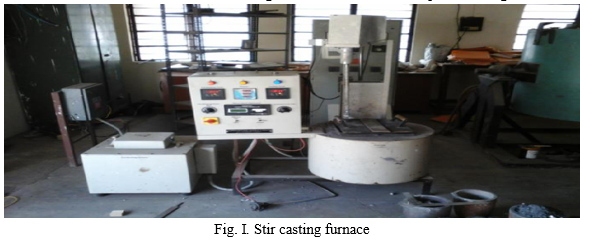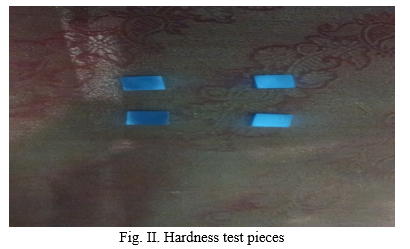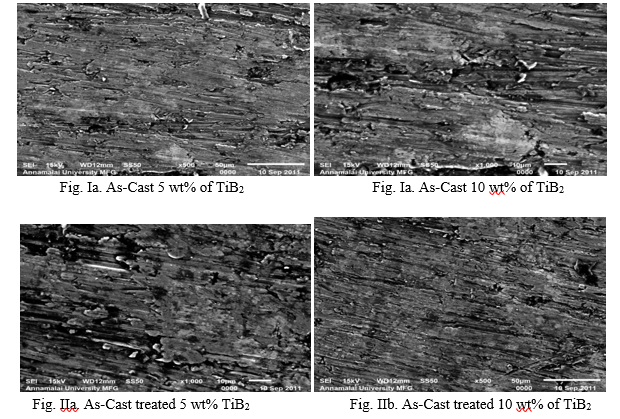Ijraset Journal For Research in Applied Science and Engineering Technology
- Home / Ijraset
- On This Page
- Abstract
- Introduction
- Conclusion
- References
- Copyright
Elevated Percentage Mechanical Properties of in-situ Synthesized TiB2/Al Matrix Composites
Authors: Dr. M. M. Siva, Dr. R. Rajesh, S. G. Arul Sabareeswara Raj
DOI Link: https://doi.org/10.22214/ijraset.2022.44199
Certificate: View Certificate
Abstract
Make use of TiB2 salts with Al-2011 fabricated by stir cast method. In the composites of Particulate reinforced varies in non-uniform microstructure and the composition in a 5 and 10 percentage of TiB2 in functional performance of a component with continuously changing properties. In mechanical, aeronautical and marine field Al 2011 is used due to its good mechanical and corrosion resistance. TiB2 is combined with Al 2011 also increases the mechanical corrosion resistance properties. MMc of Al-2011 by stir cast method titanium and boride salt were used. InTiB2 5% and 10% the tension tests and hardness tests were performed on the as cast or after heat treated samples to find the microstructure and the effect of reinforcement on the mechanical properties.
Introduction
I. INTRODUCTION
Above the last fourty years composite materials, ceramics and plastics have been the commanding appear materials. Mean while the composites have already proven their worth as weight less Materials. Modern composite materials constitute amazing proportion of the engineered materials market trading from day-by-day products to sophisticated calling applications. Aluminum matrix composites (AMCs) have prominent mechanical properties such as better mechanical strength, good microstructure. Aluminium 2011is used as the matrix and in TiB2 5% and 10% is used as the reinforcement experiment. For this Potassium hexafluro titanate and potassium tetrafluro borate salts (K2TiF6 and KBF4) has been added. The properties like hardness testing is done using the Zwick micro Vickers hardness tester and tensile tests are carried out using the Instron universal testing machine for the aluminium metal matrix composite. The scanning electron microscopy is used to measure the composites under 500 and 1000 magnification. This system is simple and controllable, correctly has great potential value in large-scale industrial application.
II. AL-TIB2 MMCS
Metal matrix composites in mostly, make of at least two components, one is the metal matrix and another one component is reinforcement. Generally the matrix is defined as a metal in all cases, but a pure metal is lightly used as the matrix. It is mostly an alloy. In the productivity of the composite the matrix and the reinforcement are mixed together. In the casting is dominated by the mechanical industry to grow at the expense of iron castings. The composites reduce vehicle weight and to increase fuel efficiency. Melting point of Al is 660°C and is light weight, density is about 1/3 that of steel or copper alloys. It has good malleability, formability, high thermal conductivity and high corrosion resistance. In addition of TiB2 with Al-2011 increases the strength of the aluminium metal matrix composites. In the last few years, Al2011-TiB2 have been utilized in high-tech structural and functional applications including aerospace, defense, automotive, and thermal management areas, as well as in sports and many other industries, and above all - in the automotive industry [1].
III. INVESTIGATIONAL STEPS
Mainly of the engineering properties of alloys are related to their structure. In the equilibrium structure can be captured for an alloy with the help of an equilibrium diagram. Mechanical properties can be changed by deferring the respective properties of micro constituents. In the experiment change in mechanical properties are developed by the process of heat treatment. The process consists of heating a metal or alloy to a specific predetermined temperature. The Al-2011 alloy is one of the commonly used after heat treatment for various applications. It has also proven as a potential matrix alloy in the fabrication of cast aluminium matrix composites.
3K2TiF6 + 22Al + 6KBF4 → 3Al3Ti + 3AlB2 + 9KAlF4+ K3AlF6 +Heat …………..(1)
3Al3Ti + 3AlB2 → 12Al + 3TiB2………………………………………………………(2)
The Al-2011alloy is far dominant matrix system for metal matrix composites. It is in general a low cost material, which presents a low melting point, facilitating fabrication [2].
A. Stir Casting
The composites are fabricated mainly by liquid metal stir casting techniques. Aluminium alloy is melted in a clay graphite crucible using resistance-heated furnaces. The composite synthesis is carried out in 10 Kg capacity furnace with temperature 9000 C. The melt temperature was maintained at ≈8700C. The current rating was maintained at 20 Amps and voltage at 110 V.

After mixing of salts was started the melt temperature was maintained between 865 - 8700C.Within 15 minutes all the salts were completely dropped into the melt and for an additional 15 minutes the stirring was continued. After 30 minutes of stirring in total the melt which was at ≈8650 C was poured into permanent molds. One of the ingot casting weighted 2.13 kg and another of the ingot casting weighted 1.03 kg. The number of heating elements used is 6 in series and almost the ingot castings no visual defects were found [3].
TABLE I. Various weight % of salts with aluminium chips
|
|
Weight (gms) for 5 % TiB2 |
Weight(gms) for 10% TiB2 |
|
Al chips |
980 |
2940 |
|
K2Ti F6 |
68.2 |
613.8 |
|
K B F4 |
72.4 |
651.6 |
B. Heat Treatment
In the investigation the prepared test specimens (5 and 15% by varying weight of TiB2) was heated in pre heater furnace up to 4000C and holding at these higher temperature for 48 hrs followed by air cooling. After quenching the specimens are cooled to room temperature for further forecasting of mechanical behaviors.
C. Microstructural Analysis
SEM was conducted at magnification of 500X and 1000X for various weight proportions of the TiB2 particles reinforced with Al. Microstructure analysis was done on the Al-2011components fabricated using stir casting. Samples for characterization were prepared using standard metallographic techniques. The gradations of the particles from outer to the inner periphery were analyzed using optical microscope [3].Convenient specimens are prepared from the sectioned rectangle components. Scales are removed from the area for macroscopically examination by polishing on successively finer emery papers, of grid size 500, 1000. Liquid soap and water are used to wash the specimen. The orientation of polishing surfaces was changed by 90°.The disk polishing has been carried out in a rotating wheel fixed with silvet cloth (around 500 rpm) with a gentle applied pressure and using diamond paste of varying size ranging from 6, 3, 1 and “0.25” μm [4].
IV. RESULTS AND DISCUSSION
The Graded components of TiB2 reinforced Aluminum composite was fabricated using the Stir casting technique. In addition, salt 5% and 10% for comparison. The samples were cut from the cast of bar and they are polished using disk polishing technique with polishing pastes of different microns to vision the microstructure of the composites.
A. Mechanical Properties
“Fig. I,” shows the tensile test for the alloy and composite samples are done using Instron UTM. The tensile stress of the composites improves significantly with the TiB2 content.

TABLE II. Tensile test results
|
Tensile Samples |
UTS (Mpa) |
Load at maximum tensile stress(N) |
% Elongation |
|
For 5 % TiB2 |
182 |
9160 |
142.8 |
|
For 10% TiB2 |
202 |
9310 |
165.2 |
Evaluated for various Al/TiB2 composites of tensile properties like ultimate tensile stress, load at maximum tensile stress, and the percentage of elongation. The ultimate tensile stress, load at maximum tensile stress values are increases as the weight percentage of TiB2 particles increases in composites. However, the percentage of elongation decreases with the increase in the weight percentage of TiB2 particles [5]. The square samples of 10mmX10mm cast composites of Al/TiB2 were machined to the hardness test specimens as per ASTM standards. From the experiment the hardness value is more in the as-cast heat treated 5% and 10% samples. The graph shows the variation in the hardness from the after and before heat treatment. Due to the chill zone near the mould wall extreme end shows less hardness. Hereafter the treated samples there exists higher hardness and also gradual increase in hardness [6].

“Fig. II,” shows the Vickers hardness samples for the as-cast condition. The hardness values in the chill zone are 114 HV, 115HV and 117 HV in 5%, 10% as-cast conditions. The higher hardness values of the 10% heat treated as-cast samples compare to the before heat treated samples. The hardness values in the 10% heat treated samples are 120 HV, 123 HV and 125 HV in as-cast conditions [7].
B. Microstructure evaluation of the as-cast composite
“Fig. Ia and Ib” shows the optical micrographs of the as-cast composite and “Fig. IIa and IIb” shows the optical micrograph of the heat treated composite samples, taken at different locations from outer periphery of the casting. Higher concentration of particle is present near the outer periphery and inner periphery shows particle depletion. The region very close to the outer periphery (0–2 mm) shows lower particle concentration compared to the adjacent region (3–9 mm) due to the chill zone formation, immediately after the metal is poured into the mould. Due to the heat treatment, the region beyond sample will get higher concentration of particle. The particle rich and particle depleted region are formed between the particle graded regions (6– 10 mm). The region near the inner periphery, i.e. beyond 12 mm from outer periphery shows the presence of porosities and agglomerated particles [8].

“Fig. I” [(a) and (b)] shows the presence of TiB2 particles in the composites with 5 and 10wt% of TiB2 showing their uniform distribution in the matrix. “Fig. II” [(a) and (b)] shows the heat treated composite samples, the TiB2 particles are significantly distributed more uniform [9].
Conclusion
In the analysis the production and properties of Al-2011 with TiB2 particles reinforced aluminum matrix composites. Slag metal reactions were used to produce composites, with the use of Al-2011 and TiB2 crinoline which are not expensive materials. The amounts of particles in the composites were 5%, 10% by volume and the matrix was aluminum. The hardness value of the heat treated composites improve significantly with the TiB2 content was determined. The examination of micro structured fracture surface for the tensile specimen clearly demonstrate that the wt 10% of TiB2 particles to the Al-2011 metal matrix composite fracture indicating the composite is of brittle material. The grains were significantly refined with the formation of TiB2 particles. The heat treated TiB2 reinforcement content in the Al-2011 matrix increases the strength.
References
[1] Jha, C. Dometakis, 1997, “The dispersion mechanism of TiB2 ceramic phase in molten aluminium and its alloys” Materials & Design 18, pp. 297-301. [2] M.K. Aghajanian, M.A. Rocazella, J.T. Burke, S.D.Keck “The Fabrication of Metal Matrix Composites by a Pressureless Infiltration Technique” Material Science 26(1991), pp.447- 454. [3] T.V. Christy, N. Murugan, S. Kumar “A Comparative Study on the Microstructures and Mechanical Properties of Al 6061 Alloy and the MMC Al 6061/TiB2/12p” Minerals & Materials Characterization & Engineering, 9(2010), pp.57-65. [4] J.V. Wood, P. Davies, J.L.F. Kellie “Properties of reactively cast aluminium-TiB2 alloys” Material Science and Engineering 9 (1993 ), pp.833-840. [5] X. Wang et al 1999, “ Microstructural analysis of Al alloys dispersed with TiB2 particulate for MMC applications “ Journal of Microscopy, 196, pp 137-145. [6] I. Gotman, M.J.Koczak, E. Shtessel “Fabrication of Aluminium Matrix in-situ Composite via Self propegating synthesis “ Material Science and Engineering A (1994), pp.189-199. [7] W.O.Soboyejo, R.J.Lederich, S.M.L. Sastry “Mechanical Behaviour of Damage Tolerant TiB2 whisker reinforced in-situ titanium matrix composites” Acta Metallurgica 42(1994) , pp.2579-2591. [8] Yuyong chen, Chung, D.D.L. In-situ Al-TiB2 Composite Obtained by Stir casting, Journal Material Science 31(1996), pp.311-315. [9] I.G. Watson et al. 2005, “Investigation of the clustering behaviour of titanium diboride particles in aluminium” Composites: Part A, 36, pp 1177-1187. l. 1, Issue 3, (2014), pp.156 158. [10] P. Davies, J.L.F. Kellie, J.V.Wood, “Fundamentals of Metal Matrix Composites” Key Engineering M saterial 357(1993), pp.77-78. [11] Feng C.F.,Froyen L “Microstructure of in-situAl/TiB2 MMCs Prepared by Casting Route” Material Sciences 35(2000) , pp.837-850.
Copyright
Copyright © 2022 Dr. M. M. Siva, Dr. R. Rajesh, S. G. Arul Sabareeswara Raj. This is an open access article distributed under the Creative Commons Attribution License, which permits unrestricted use, distribution, and reproduction in any medium, provided the original work is properly cited.

Download Paper
Paper Id : IJRASET44199
Publish Date : 2022-06-13
ISSN : 2321-9653
Publisher Name : IJRASET
DOI Link : Click Here
 Submit Paper Online
Submit Paper Online

